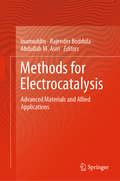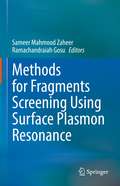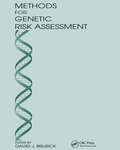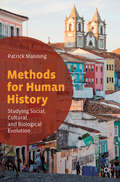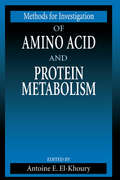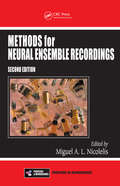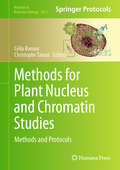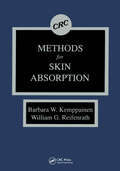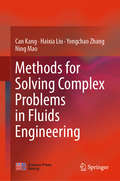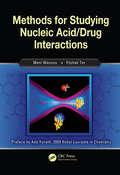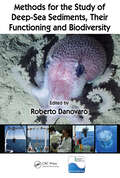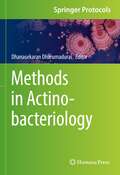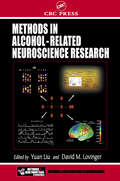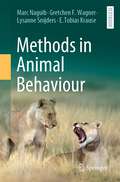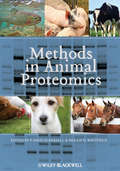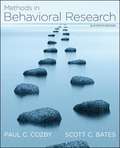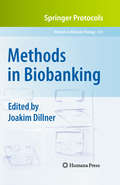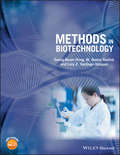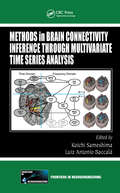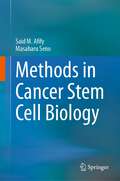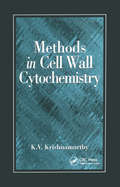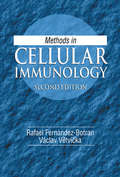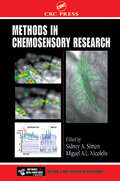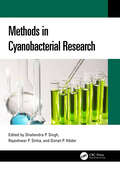- Table View
- List View
Methods for Electrocatalysis: Advanced Materials and Allied Applications
by Inamuddin Abdullah M. Asiri Rajender BoddulaThis book explores key parameters, properties and fundamental concepts of electrocatalysis. It also discusses the engineering strategies, current applications in fuel-cells, water-splitting, metal-ion batteries, and fuel generation. This book elucidates entire category viewpoints together with industrial applications. Therefore, all the sections of this book emphasize the recent advances of different types of electrocatalysts, current challenges, and state-of-the-art studies through detailed reviews. This book is the result of commitments by numerous experts in the field from various backgrounds and expertise and appeals to industrialists, researchers, scientists and in addition understudies from various teaches.
Methods for Fragments Screening Using Surface Plasmon Resonance
by Sameer Mahmood Zaheer Ramachandraiah GosuThis volume describes methods and protocols for the fragment-based screening of proteins using Surface Plasmon Resonance (SPR). The initial chapter of the book discusses the principle of SPR for the identification of biomolecular interactions, while the subsequent chapters introduce methods for labelling proteins with different tags including, histidine and biotin tags. It also discusses techniques and factors that affect the amine and biotin-streptavidin coupling and methods to optimize the interactions. Next, it describes fragment preparation for screening in SPR and presents methods to calculate equilibrium dissociation constant (KD) and ligand efficiency (LE). It reviews techniques of next-generation injections that improve the efficiency of the characterization process over traditional SPR by determining the kinetics and affinity in a single step. Finally, the book elucidates a comprehensive yet representative description of challenges associated with the molecular interaction of proteins using SPR.
Methods for Genetic Risk Assessment
by David BrusickGenetic disease contributes to a major portion of our health care costs. While most of the human genetic burden is transmitted from generation to generation, environmental chemicals capable of reacting with germ cell DNA could produce new mutations, resulting in an even greater genetic liability for the next generation. The potential impact of environmental mutagens on the health and viability of other living things is important to consider as well. Methods for Genetic Risk Assessment features contributions from international experts to provide a comprehensive review of the current status of genetic risk assessment. You'll learn about various methods and strategies for when and how to conduct genetic risk assessments on human populations. You will also learn about the potential effects of environmental genotoxins on nonhuman organisms.
Methods for Human History: Studying Social, Cultural, and Biological Evolution
by Patrick ManningThis book presents a concise yet comprehensive survey of methods used in the expanding studies of human evolution, paying particular attention to new work on social evolution. The first part of the book presents principal methods for the study of biological, cultural, and social evolution, plus migration, group behavior, institutions, politics, and environment. The second part provides a chronological and analytical account of the development of these methods from 1850 to the present, showing how multidisciplinary rose to link physical, biological, ecological, and social sciences. The work is especially relevant for readers in history and social sciences but will be of interest to readers in biological and ecological fields who are interested in exploring a wide range of evolutionary studies.
Methods for Imaging Cell Membranes (Series in Cellular and Clinical Imaging)
by Luca Panconi Daniel Nieves Maria Makarova Dylan OwenThis book will serve as an introduction to microscopy and biomedical imaging methods, with a focus on the study of the distributions and dynamics of molecules on the cell surface. It will provide readers with an in-depth understanding of how modern microscopy methodology can be used to understand the organisation of cell membrane systems and how experiments can be designed around these methodologies. There are numerous methods employed to understand cell membrane organisation, but foremost among them are microscopy methods which can map the distributions of molecules on the cell surface and even map the biophysical properties of membranes themselves. Fluorescence microscopy has been especially widely used due to its specificity and relatively noninvasive nature, allowing live-cell imaging. However, the recent advance of super-resolution fluorescence microscopy has broken the previous resolution limit for this type of microscopy, which has been an important advancement in the field. Atomic force microscopy and electron microscopy have also been deployed to learn about membrane organisation and properties. Each chapter in this volume will be themed around measuring a particular property of cell membranes. In each case, the authors examine the range of methodology applicable to the task, comparing the advantages and disadvantages of each one, and will also provide an overview of important discoveries that have been made using the methodology being discussed. The chapters will cover: • Measuring membrane protein distributions using single-molecule localisation microscopy (SMLM) • Measuring membrane protein dynamics and diffusion using fluorescence correla-tion spectroscopy (FCS) • Mapping membrane lipid backing using environmentally sensitive fluorescence probes • Mapping membrane thickness and rigidity using atomic force microscopy • Mapping membrane proteins and the cytoskeleton using electron microscopy This book will be a valuable resource to graduate and upper-level undergraduate students and industry researchers in the fields of cell biology, microbiology, microscopy, and medical imaging.
Methods for Investigation of Amino Acid and Protein Metabolism (Methods In Nutritional Research Ser. #2)
by Antoine E. El-KhouryContaining all the new as well as classical methodologies used in the investigation of amino acid and protein metabolism in human and animal models, this book is needed because of the dramatic increase in research in this field. There is no other book currently on the market that covers these methods of investigation.Methods for Investigation of Amino Acid and Protein Metabolism explores areas such as amino acid transfer across tissue membranes, past and new applications using stable isotopes, protein synthesis in organs and tissues, and more. Because of the importance of research methods in the field of amino acid and protein nutrition and metabolism, this book facilitates the reader's integration of the concepts involved in these investigative research methods and their corollaries.In addition to helping any nutrition investigator design and conduct appropriate research protocols in this area of nutrition, this book assists students who are planning to investigate amino acid and protein metabolism in humans or laboratory animals.
Methods for Neural Ensemble Recordings (Frontiers in Neuroscience)
by Miguel A. L. NicolelisExtensively updated and expanded, this second edition of a bestseller distills the current state-of-the-science and provides the nuts and bolts foundation of the methods involved in this rapidly growing science. With contributions from pioneering researchers, it includes microwire array design for chronic neural recordings, new surgical techniques for chronic implantation, microelectrode microstimulation of brain tissue, multielectrode recordings in the somatosensory system and during learning, as well as recordings from the central gustatory-reward pathways. It explores the use of Brain-Machine Interface to restore neurological function and proposes conceptual and technical approaches to human neural ensemble recordings in the future.
Methods for Plant Nucleus and Chromatin Studies: Methods and Protocols (Methods in Molecular Biology #2873)
by Célia Baroux Christophe TatoutThis volume provides a comprehensive collection of protocols that can be used to study plant chromatin structure and composition. Chapters divided into five sections detail the profiling of chromatin features in relation to epigenetic regulation, investigate the interaction between chromatin modifications and gene regulation, and explore the 3D spatial organization of the chromatin inside the nucleus. Written in the highly successful Methods in Molecular Biology series format, chapters include introductions to their respective topics, lists of the necessary materials and reagents, step-by-step, readily reproducible laboratory protocols, and key tips on troubleshooting and avoiding known pitfalls. Authoritative and cutting-edge, Methods for Plant Nucleus and Chromatin Studies: Methods and Protocols aims to ensure successful results in the further study of this vital field.
Methods for Skin Absorption
by Barbara W. Kemppainen William G. ReifenrathThis up-to-date volume describes the wide variety of available methods concerning percutaneous absorption of drugs and toxins. It discusses in detail the advantages and disadvantages of each method. This unique publication provides a clear, systematic presentation of each aspect which must be considered when designing and performing skin penetration experiments and when interpreting results. It includes specific information regarding necessary supplies and equipment, along with commercial sources for these items. This state-of-the-art book is an ideal instructional manual for investigators uninitiated in performing percutaneous absorption and metabolism studies. Those involved with investigative dermatology, dermatological research, toxicology, and pharmacology will find this reference interesting and indispensable.
Methods for Solving Complex Problems in Fluids Engineering
by Can Kang Haixia Liu Yongchao Zhang Ning MaoThis book describes recently developed research methods used to study complex problems in fluid engineering, especially optical flow measurement, flow visualization and numerical methods. It includes a wealth of diagrams and images, and the content is presented in a step-by-step manner from beginning to end, helping readers grasp the central points of the book.The book also presents a number of practical cases, illustrating how the research methods covered can be concretely implemented. Lastly, the book offers a valuable point of departure for pursuing further research.
Methods for Studying Nucleic Acid/Drug Interactions
by YorkMeni Wanunu•Yitzhak TorSince most therapeutic efforts have been predominantly focused on pharmaceuticals that target proteins, there is an unmet need to develop drugs that intercept cellular pathways that critically involve nucleic acids. Progress in the discovery of nucleic acid binding drugs naturally relies on the availability of analytical methods that assess the eff
Methods for the Study of Deep-Sea Sediments, Their Functioning and Biodiversity
by Roberto DanovaroFor years scientists viewed the deep sea as calm, quiet, and undisturbed, with marine species existing in an ecologically stable and uniform environment. Recent discoveries have completely transformed that understanding and the deep sea is recognized as a complicated and dynamic environment with a rich diversity of marine species. Carefully designe
Methods in Actinobacteriology (Springer Protocols Handbooks)
by Dhanasekaran DharumaduraiThis volume details techniques on the study of Isolation, characterization, and exploration of actinobacteria in industrial, food, agricultural, and environmental microbiology. Chapters cover a wide range of basic and advanced techniques associated with research on isolation, characterization and identification of actinobacteria in soil, sediment, estuarine, water, Saltpan, Mangroves, plants, lichens, sea weeds, sea grass, animals-crab, snail, shrimp. Authoritative and cutting-edge, Methods in Actinobacteriology aims to be a useful practical guide to researches to help further their study in this field.
Methods in Alcohol-Related Neuroscience Research (Frontiers in Neuroscience)
by David M. Lovinger Yuan LiuWritten by a panel of experts, Methods in Alcohol-Related Neuroscience Research not only provides information of a technical nature but also gives an overview of the many areas in investigating the effects of alcohol on the brain. It gives technical guidance for investigators doing research at the molecular, cellular, systems, and behavioral levels. These techniques include a wide variety of approaches, ranging from gene mapping and examination of molecular interactions of alcohol at the sub-cellular level to recording of neural activities in freely-behaving animals and imaging alcohol effects on the living human brain.
Methods in Animal Behaviour
by Marc Naguib E. Tobias Krause Gretchen F. Wagner Lysanne SnijdersMarc Naguib erklärt die grundlegenden Methoden der qualitativen und quantitativen Erfassung von Verhalten. Dabei werden deskriptive und experimentelle Ansätze von Versuchsplänen berücksichtigt. Anhand von Beispielen aus der aktuellen Forschung wird die Breite der modernen verhaltensbiologischen Forschung anschaulich dargestellt.
Methods in Animal Proteomics
by David Eckersall Philip WhitfieldThe study of proteomics provides researchers with a better understanding of disease and physiological processes in animals. Methods in Animal Proteomics will provide animal scientists and veterinarians currently researching these topics in domestic animals a firm foundation in the basics of proteomics methodology, while also reviewing important advances that will be of interest to established researchers in the field. Chapters will provide practical information on a range of topics including protein identification and separation, bioinformatics, and applications to disease and reproduction research. This text will be written by leading international proteomics experts and essential for researchers in the fields of animal biology and veterinary medicine.
Methods in Behavioral Research (Eleventh Edition)
by Paul C. Cozby Scott C. BatesMethods in Behavioral Research has achieved its market-leading position with its concise and strategic approach to methodological decision making. Combining helpful pedagogy and rich examples, Cozby's eleventh edition again incorporates learning objectives, illustrative graphics, and activities to increase student involvement. Highlights of the new edition include a broader introduction of different research techniques in Chapter 4, extensive revision of the “validity of measurements̶ section, and updated structural equations models.
Methods in Biobanking
by Joakim DillnerInternational biobank collaborations allow for studies with large number of subjects where generalizability of findings across populations can be investigated, which means establishing quality criteria concerning the nature of the sample, conditions of sample storage, and the adequacy of available information is of vital importance. Methods in Biobanking brings together contributions from experts in the field in order to aid in the establishment of this much needed consistency. The volume discusses how to use existing collections of biological material to answer significant questions concerning the cause of disease without violating the personal integrity of participating sample donors, the ethical issues surrounding biobanks, guidelines for the use of coding systems and the use of biocomputing and registry linkages in research projects, as well as many other key subjects. As a volume in the highly successful Methods in Molecular BiologyTM series, this collection provides the kind of detailed description and implementation advice that is crucial for getting optimal results. Authoritative and cutting-edge, Methods in Biobanking seeks to provide scientists with the tools necessary to take advantage of the tremendous current resources of the world's biobanks and strengthen those resources for the future.
Methods in Biotechnology
by Lory Z. Santiago-Vázquez Seung-Beom Hong M. Bazlur RashidAs rapid advances in biotechnology occur, there is a need for a pedagogical tool to aid current students and laboratory professionals in biotechnological methods; Methods in Biotechnology is an invaluable resource for those students and professionals. Methods in Biotechnology engages the reader by implementing an active learning approach, provided advanced study questions, as well as pre- and post-lab questions for each lab protocol. These self-directed study sections encourage the reader to not just perform experiments but to engage with the material on a higher level, utilizing critical thinking and troubleshooting skills. This text is broken into three sections based on level - Methods in Biotechnology, Advanced Methods in Biotechnology I, and Advanced Methods in Biotechnology II. Each section contains 14-22 lab exercises, with instructor notes in appendices as well as an answer guide as a part of the book companion site. This text will be an excellent resource for both students and laboratory professionals in the biotechnology field.
Methods in Brain Connectivity Inference through Multivariate Time Series Analysis (Frontiers in Neuroengineering Series)
by Koichi Sameshima Luiz Antonio BaccaláInterest in brain connectivity inference has become ubiquitous and is now increasingly adopted in experimental investigations of clinical, behavioral, and experimental neurosciences. Methods in Brain Connectivity Inference through Multivariate Time Series Analysis gathers the contributions of leading international authors who discuss different time series analysis approaches, providing a thorough survey of information on how brain areas effectively interact. Incorporating multidisciplinary work in applied mathematics, statistics, and animal and human experiments at the forefront of the field, the book addresses the use of time series data in brain connectivity interference studies. Contributors present codes and data examples to back up their methodological descriptions, exploring the details of each proposed method as well as an appreciation of their merits and limitations. Supplemental material for the book, including code, data, practical examples, and color figures is supplied in the form of downloadable resources with directories organized by chapter and instruction files that provide additional detail.The field of brain connectivity inference is growing at a fast pace with new data/signal processing proposals emerging so often as to make it difficult to be fully up to date. This consolidated panorama of data-driven methods includes theoretical bases allied to computational tools, offering readers immediate hands-on experience in this dynamic arena.
Methods in Cancer Stem Cell Biology
by Said M. Afify Masaharu SenoThis book describes the use of stem cells and cancer stem cell generation in the inflammatory microenvironment (cancer-inducing niche) using induced pluripotent stem cells. It provides step-by-step techniques and manuals for studying stem cell and cancer stem cell generation with different applications in cancer research. The development of induced pluripotent stem cells has provided a new approach to studying cancer initiation by producing cancer stem cells without introducing mutations or foreign genes. The book features the research of the authors’ group, which was the first to generate cancer stem cells from stem cells in the presence of inflammatory conditions. The 20 chapters of this book cover topics such as generating pluripotent stem cells, converting normal stem cells to cancer stem cells, enriching, isolating and evaluating cancer stem cells. Methods for evaluating the characteristics of cancer stem cells and possible therapies against them are also discussed. The book provides easy-to-follow protocols that help researchers in the study of cancer stem cells. Illustrations help readers understand how the method of cancer stem cell generation can be applied as an essential method for assessing the carcinogenic potential of various non-mutagenic compounds. It will be a useful resource for graduate students, researchers, technicians, and physicians working in academic, hospital, and pharmaceutical settings.
Methods in Cell Wall Cytochemistry
by K V KrishnamurthyVarious methodologies designed to study cell walls are compiled in this book. Methods in Cell Wall Cytochemistry covers the use of modern dyes, fluorescent chemicals, lectins, and antibody technology (immunocytochemisty.)Cell wall morphology and chemical composition is covered as well as light and fluorescent cytochemistry; transmission electron microscopic cytochemistry; lectin cytochemistry; and, special emphasis on immunocytochemistry. Addressing an emerging area of research and technology, this book will appeal to plant pathologists, cell biologists, as well as workers interested in stress response and those employing cell walls for biotechnological research.
Methods in Cellular Immunology
by Rafael Fernandez-Botran Vaclav VetvickaA step-by-step guide to commonly used procedures, Methods in Cellular Immunology addresses both human and murine models, in addition to such topics as PCR and apoptosis. The basic format of the original version has been maintained, and the goal remains the same: to make it a useful and easy-to-use tool for investigators employing cellular immunolog
Methods in Chemosensory Research (Frontiers in Neuroscience)
by Sidney A. Simon Miguel A.L. NicolelisMethods in Chemosensory Research describes new molecular, electrophysiological, engineering, genetic, behavioral, psychophysical, and imaging techniques that have recently been adapted to investigate the basic neuronal mechanisms underlying chemoreception. Written by leaders in the field of neuronal chemoreception specializing in olfaction, gustation, baroreception, and chemical irritation caused by environmental pollutants, this unique book combines novel methods to investigate all aspects of taste and olfaction. These methods range from the molecular level to the investigation of individual cell taste and olfactory epithelia.
Methods in Cyanobacterial Research
by Rajeshwar P. Sinha Donat-P. Häder Shailendra P. SinghThis laboratory reference compiles the essential protocols used in cyanobacterial research. Cyanobacteria is a model system for biofuel production and sequestration of carbon dioxide to tackle global climate change due to increasing levels of greenhouse gases. Topics range from identification and growth parameters to biomolecule estimation and isolation. It also covers genome analysis and bioengineering of cyanobacteria for novel products.Key Features: Provides step-by-step procedures and troubleshooting tips Covers identification, growth parameters and pigment estimation methodologies Describes isolation, characterization and purification of microcystin, phycobiliproteins and scytonemin from cyanobacteria Discusses genomics, proteomics and bioengineering of cyanobacteria from novel products Explains sample preparation and visualization protocol for electron microscopy-based analysis of cyanobacteria This collection is useful to students and researchers in life sciences. It is also meant for industry experts who are involved in the production of biofuels, biofertilizers, other value-added products, and carbon sequestration using cyanobacteria.
